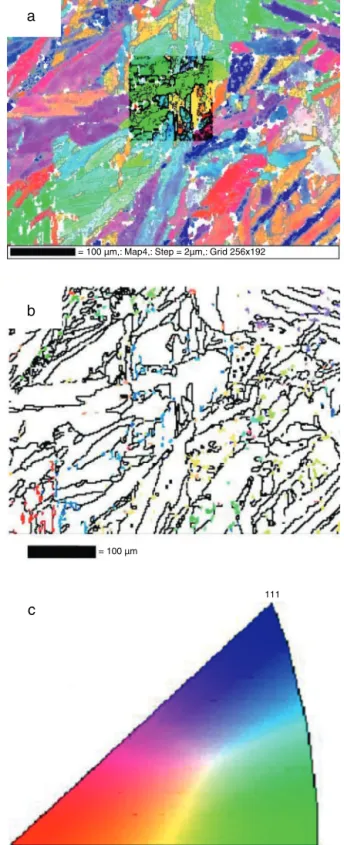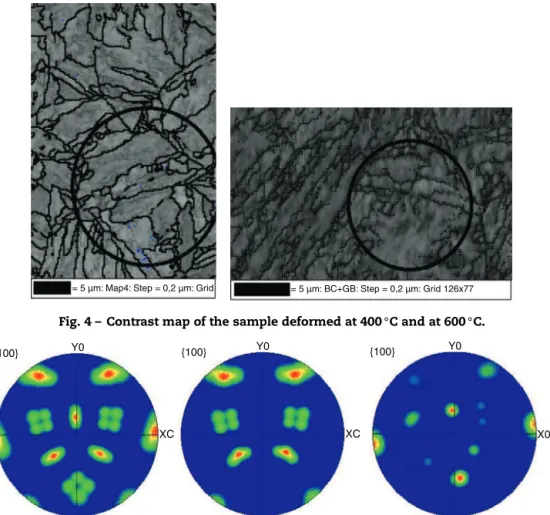Availableonlineatwww.sciencedirect.com
w w w . j m r t . c o m . b r
Original
Article
The
variant
selection
in
the
transformation
from
austenite
to
martensite
in
samples
of
maraging-350
steel
Neuman
Fontenele
Viana
∗,
Cristiana
dos
Santos
Nunes,
Hamilton
Ferreira
Gomes
de
Abreu
UniversidadeFederaldoCeará,Fortaleza,CE,Brazil
a
r
t
i
c
l
e
i
n
f
o
Articlehistory:
Received19February2013 Accepted25March2013 Availableonline17October2013
Keywords:
Maragingsteel
Martensitetransformation Variantselection
a
b
s
t
r
a
c
t
Experimentshave been conducted to study the variant selection phenomenon in the transformationfromaustenitetomartensiteinmaraging-350steel.Thetransformationof austenitetomartensiteinmaragingsteelsoccursattemperaturesbelow300◦Cdepending onthealloychemicalcomposition.Thetransformationtomartensiteinthesesteelsoccurs regardlessofthecoolingrate.Inthesesteels,therevertedaustenitepresentsthesame crys-tallographictextureofthemotheraustenite.Samplesofmaraging-350wereaustenitizedat 860◦Cinsideafurnaceattachedtoatensiontestmachineandthencooledinthefurnace untilthetemperatureof600◦Cand400◦C.Atthesetemperaturessamplesweredeformedby compressionwith10%reductioninheight.Afterdeformationtheappliedforcewasremoved andsampleswerecooledtoroomtemperatureinair.Asecondgroupofsampleswas sub-jectedtothesameaustenitizationandcooleduntil300◦Cwhenitwasappliedacompressive stresswithmagnitudebelowtheyieldstrength.Withtheforceapplied,thesampleswere aircooledtoroomtemperature.EBSDanalysiswasperformedincross-sectionofsamples todeterminetheinfluenceofplasticdeformationbeforethetransformationandalsothe influenceofastressintheelasticregimeintheselectionofvariantsofmartensite.Measured polefigureswerecomparedwithcalculatedonesusingthephenomenologicalmartensite transformationconceptassociatedwithPatel–Cohenmodel.
©2013BrazilianMetallurgical,MaterialsandMiningAssociation.PublishedbyElsevier EditoraLtda.
1.
Introduction
Maragingsteelsbelongtoafamilyofcarbonfreeiron–nickel alloyswithadditions ofcobalt, molybdenum,titanium and aluminum.Thetermmaragingisderivedfromthe strengthen-ingmechanism.Marfrommartensite+agingmeansthatthe
∗ Correspondingauthor.
E-mail:neumanfv@gmail.com(N.F.Viana).
alloytransformstomartensitewithsubsequentage harden-ing.Thisfamilyofsteelsfindsimportantapplicationswhere ultra-highstrengthisrequired,alongwithgooddimensional stabilityduringheattreatment[1].
Thetransformationofaustenitetomartensitein marag-ing steelsoccurs regardlessofthecoolingrate. TheAs, Af,
MsandMftemperaturesweremeasuredfortheMAR350cold
2238-7854 ©2013BrazilianMetallurgical,MaterialsandMiningAssociation.PublishedbyElsevierEditoraLtda.
http://dx.doi.org/10.1016/j.jmrt.2013.03.017
Este é um artigo Open Access sob a licença de CC BY-NC-ND
(111) Cube texture
ϕ1
φ
40 50 60 70 80 90 100 2θ (º)
110 650˚C
600˚C
500˚C
480˚C
450˚C
α
α γ α γ
Fig.1–(a)ϕ2=45◦odfsections;(b)X-raydiffractogramsforthemartensitephaseofsamplesagedat450◦C,480◦C,500◦C
and650◦C.
deformed80%usingthermo-magneticanalysis.The temper-atures were found to be 690◦C, 800◦C, 175◦C and 130◦C,
respectively[1].
Nakadaetal.havestudiedthe reversionofaustenite in a martensitic stainless steel and concluded that most of revertedaustenitehadthesame orientationastheoriginal austenitematrixbeforemartensitictransformation.Theyalso suggestedthatrevertedausteniteretainedaKurdjmov–Sachs relationshiptomartensite[2].
Thetheoryconcernedwithmartensitetransformationis wellestablished.Thecrystallographyofeachplateof martens-itecanbedescribedintermsofamathematicallyconnected setconsistingofthehabitplane,orientationrelationshipwith theaustenite,andtheshapedeformation[3–7].
ThePatelandCohenmodelforpredictingthevariant selec-tion phenomenon isbased in the energyof appliedstress duringtransformation.Theinteractionenergythatprovides themechanicaldrivingforce fortransformationisgivenby Eq.(1)[8]:
U=N+s (1)
whereNisthestresscomponentnormaltothehabitplane, istheshearstressresolvedonthehabitplaneinthedirection ofshearan,andsarerespectivelynormalandshearstrains associatedwithtransformation[3].Thetotalfreeenergy avail-ablefortransformationisthesumofchemicalandmechanical components,accordingtoEq.(2);thelatteronebeingzeroin theabsenceofanappliedstressduringtransformation[4]:
G=GCHEM+GMECH (2)
whereGMECH≡U. It would bereasonable to assume that thereisstrongvariantselectionwhentheratioofGMECH/G
islarge[4].
Inthiswork,samplesofmaraging350wereaustenitized at860◦Cinsideafurnaceattachedtoatensiontestmachine
andthencooledinthefurnaceuntilthetemperatureof600◦C
and400◦C.Atthistemperaturethesamplesweredeformed
bycompression withreductionsinheightbelow10%.After deformationtheforcewasremovedandsampleswerecooled toroomtemperature.Asecond groupofsampleswas sub-jectedtothesameaustenitizationandcooledto300◦Cwhen
it was appliedacompressive stress withmagnitudebelow theyieldstrength.Withtheforceapplied,thesampleswere air cooled to room temperature. Pole figures obtained by EBSDwerecomparedwithcalculatedpolefigures basedon thephenomenologicalmartensitetransformation crystallog-raphy(PMTC)associatedtothePatel–Cohenmodel.
2.
Experimental
SamplesofforgedMAR350steelwiththecomposition19.77 Ni,10.74 Co, 4.70 Mo,1.4 Ti,0.10 Al, 0.0073C and balance ofFewereaustenitizedat860◦Cfor1handcooledinsidea
furnaceassembledtoaUniversaltestingmachine.Whenthe temperaturereached600◦Cand400◦Csampleswerepressed
resultingina10%ofplasticdeformation.Anothersamplewas cooledto300◦Cwhenacompressivestressof200MPa–below
theyieldingofMar350atthistemperature–wasappliedand keptuntiltheendoftransformation.Tofindtheorientation ofthepreviousaustenite,sampleswereagedat550◦Cfor1h
toprecipitaterevertedaustenite.
The EBSD study was performed in an Oxford Channel 5-EBSDsystemattachedtoaSEMPhilipsXL-30.Sample prepa-rationsequencewasapre-grindto600SiCandpolishto3-m diamond.Thefinalpolishingwasdoneusingacolloidalsilica suspensionofparticlesizeof0.05mduringlongperiodsof time.X-raydiffractionwasperformedinaPhilips diffractome-termodelX’PertProusingCoK␣radiationwithanattached monochromator.
To reproduce the phenomenological theory of mar-tensite transformation crystallography the software crys-talhabitpoly.f.Detailsofuseofthissoftwareareavailablein Ref.[9].
3.
Results
Thefirst taskofthis work wastoassure that thereverted andtheparentaustenitepresentedthesamecrystallographic texture. Fig. 1a shows ϕ2=45◦ odf (orientation distribution functions)sectionsforthemartensitephaseofsamplesaged at450◦C,480◦C,500◦C and650◦C.Comparing odf’s,it can
conditionsareacubecomponent(001)[100]and the(111) fibermoreintensein{111}112.Samplesagedat500◦Cand
650◦Cshowspeaksofrevertedausteniteonthediffractogram
presentedinFig. 1band no changein the crystallographic textureofthemartensitephase.
Fig.2showsEBSDmapsformartensiteandaustenitefor asampleofmaragingagedfor1hat550◦Candcooledinair
withoutstressorpriordeformationbeforemartensite trans-formation.Thecolorofeachpointisassociatedtothelocal orientation,asshownintheorientationstandardtriangle.The selectedgrainforstudyistheoneinblueinthecentralpart ofFig.2b.
Theorientationofausteniteintheselectedgrainwas deter-minedbytheEBSDChannel5softwareandisrepresentedby the setofEuler angles– ϕ1=334.3◦, =47.9◦ and ϕ2=60.3◦. Toperformthecalculationoforientationofthemartensite resulting from the transformation, a complete set of crys-tallographicdataisnecessary. Unfortunately,such datafor maragingsteelisnotavailable.Adata thatcorresponds to thetraditionaltwinned{259}␥transformationfoundinhigh
carbonsteels,Fe–NiandFe–Ni–Cwillbeused[10–12]. The choice of lattice invariant shear (LIS) was the (112)[111]␣ twinning system inthe bcc phase, that
corre-spondsto(111)[101]␥inthefccphase.
Thefollowingdatawasobtained: MagnitudeofLIS‘g’=0.272602.
Magnitudeoftheshapestrain‘m’=0.219957.
Habitplane:
(−0.4167810.5886170.694388)␣
or
(0.1850640.594242−0.782705)␥
Shapestraindirection:
[0.628457−0.4784560.613288]␣
or
[0.2095360.6728230.709509]␥
Orientationrelationship:
[100]␥=[0.7239850.6777400.128506]␣
[010]␥=[−0.018574−0.1670690.985770]␣
[001]␥=[0.689565−0.716070−0.108367]␣
Fig. 3a shows (100) calculated pole figure for martens-ite using the phenomenological martensite transformation crystallographytheoryandassumingthatall24variantsare present,i.e.,novariantselectionisacting.Itwascompared withmeasured(100)bccpolefigureforthesameregionand ispresentedinFig.3b.Thereisaverygoodmatchbetween cal-culatedandmeasuredpolefigures.Theseresultpointstothe factthatrevertedandparentaustenitehavethesame crys-tallographictexture.Itisalsoevidentthatthereisnovariant selectioninthistransformation.
Fig.4showsthecontrastmapofacross-sectionalareaof thespecimendeformed10%atitsheightinacompressiontest performedat400◦C.Thecirclemarkedinthefigureindicates
theaustenitegrainusedtostudythecrystallographyofthe transformation.
Fig.5compares(100)calculatedpolefigurein(a)and(b) withonemeasuredbyEBSDinonegrainthatbelongs toa sampledeformed10% inits heightbythe application ofa compressiveforceat400◦C,i.e.,beforemartensite
transfor-mation.InFig.5aitwasassumedthattherewasnovariant selection. In Fig. 5b, it was assumed that some vestige of
= 100 µm,: Map4,: Step = 2µm,: Grid 256x192
a
b
= 100 µm
111
101 01
c
Fig.2–(a)EBSDmapformartensite;(b)EBSDmapfor austenite;(c)standardtriangle.(Forinterpretationofcolor inthetext,thereaderisreferredtothewebversionofthe article.)
{100} Y0 {100} Y0
X0 X0
a
b
Fig.3–Calculated(a)andmeasured(b)(100)polefigures forbccphaseinareashowninFig.2c.
comparison with the pole figure calculated assuming the modelofPatel–Cohenonerealizesthatvariantsnotpredicted bythemodelappearedaswellasvariantspredictedbythe modelarenotpresent.Theprobablereasonforthedivergence isthatafterwithdrawing theforcethatmadeplastic defor-mation inthe sample,it was placedinairfor coolingand duringcoolingthermalstressesaroseinfluencingthevariant selectionprocess.
Forthesampledeformedat600◦Cthesamephenomenon
happened. All variants predicted by the PMTC assuming 24variantsarepresentinFig.6c.Somevariantswithpositive mechanicalenergypredictedbythePatel–Cohenmodelare presentandsomenot.Therearealsovariantsnotpredicted bythemodelthatprecipitated.
= 5 µm: Map4: Step = 0,2 µm: Grid = 5 µm: BC+GB: Step = 0,2 µm: Grid 126x77
Fig.4–Contrastmapofthesampledeformedat400◦Candat600◦C.
{100} Y0 {100} Y0 {100} Y0
XC XC X0
Fig.5–(100)polefiguresforasampledeformedat400◦Cbeforetransformation:(a)calculated24variants;(b)calculated 9variants;(c)measured.
{100} Y0 {100} {100}
XC XC XC
Y0
Y0
{100} Y0 {100} {100}
X0 XC X0
Y0 Y0
Fig.7–(100)polefiguresforasamplewithelasticappliedstressduringtransformation:(a)calculated24variants; (b)calculated12variants;(c)measured.
Finallythelastsamplewasnotplasticallydeformedbefore martensitictransformationisshown inFig.7. Thissample showedaverygoodmatchbetweencalculatedpolefigureand measuredpolefigure.ThePatelandCohenmodelwas devel-opedtoanalyzetheinfluenceofstressduringtransformation. Thissamplewasnotsubjecttoanyplasticdeformationbefore martensitictransformationonlyelasticcompressivestressat thetransformationtemperature.
4.
Summary
Thephenomenologicaltheoryofmartensitecrystallography (PMTC)showedtobeveryaccuratetosimulatetransformation textureinmaraging-350steel.ThePatelandCohencriterion was very precise for predicting variant selection in sam-pleswheretransformationtookplaceundertheactionofan externalstress.Samplesplasticallydeformedintemperatures aboveMspresentedavariantselectiondifferentthanthe pre-dictedbythemodel.
Conflicts
of
interest
Theauthorsdeclarenoconflictsofinterest.
Acknowledgements
The authors are grateful to the support from CNPq (National CouncilforScientific and Technological Develop-ment)projects304503/2011-8and475825/2011-0.
r
e
f
e
r
e
n
c
e
s
[1]TavaresSSM,AbreuHFG,NetoJM,daSilvaMR,PopaI.A thermomagneticstudyofthemartensite–austenitephase transitioninthemaraging350steel.JAlloysCompd 2003;358:152–6.
[2]NakadaN,TsuchiyamaT,TakakiS,HashizumeS.Variant selectionofreversedausteniteinlathmartensite.ISIJInt 2007;47:1527–32.
[3]KunduS,BhadeshiaHKDK.Crystallographictextureand interveningtransformations.ScrMater2007;57: 869–72.
[4]KunduS,BhadeshiaHKDK.Transformationtexturein deformedstainlesssteel.ScrMater2006;55:
779–81.
[5]BowlesJS,MacKenzieJK.Thecrystallographyofmartensite transformations.ActaMetall1954;2:129–37.
[6]MacKenzieJK,BowlesJS.Thecrystallographyofmartensite transformationsII.ActaMetall1954;2:138–47.
[7]BhadeshiaHKDH.Geometryofcrystals.2nded.London: InstituteofMaterials;2001.
[8]PatelJR,CohenM.Criterionfortheactionofappliedstressin themartensitictransformation.ActaMater1953;1:
531–8.
[9]KunduS.UniversityofCambridge;2007.Availablefrom: www.msm.cam.ac.uk/phasetrans/[PhDthesis].
[10]BowdenHG,KellyPM.Thecrystallographyofthepressure inducedphasetransformationsinironalloys.ActaMetall 1967;15:1489–500.
[11]KellyPM.ISISpecialRep1964;86:146. [12]KellyPM.Themartensitetransformationin



